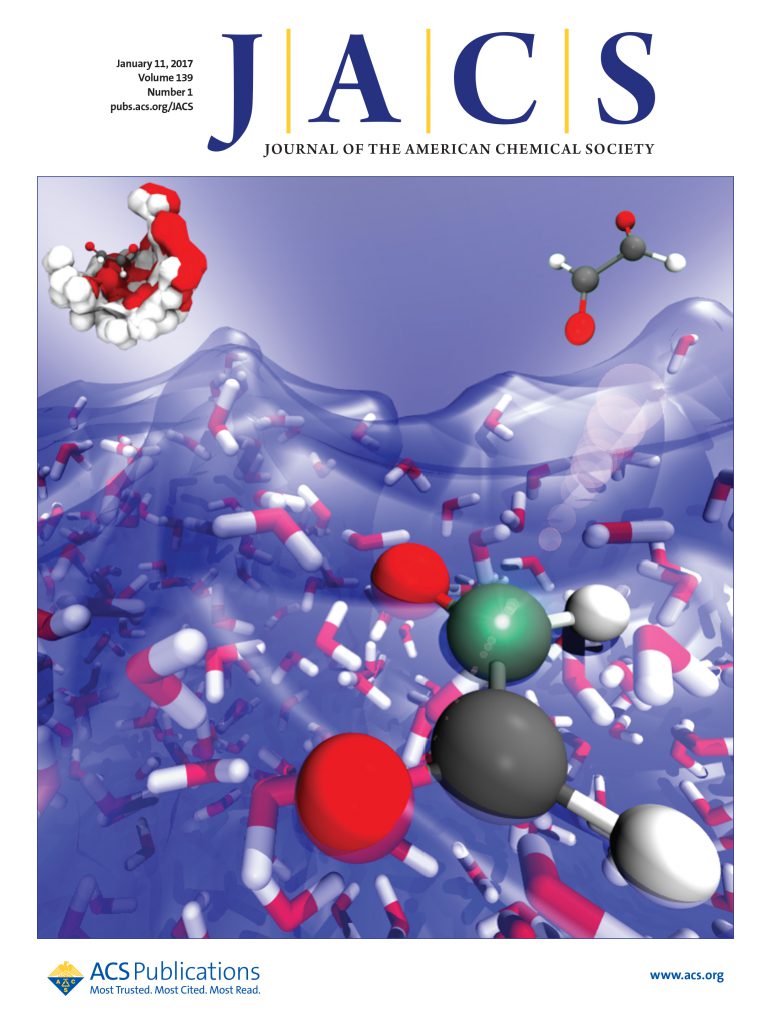原子精确金纳米团簇的压力激活高效近红外发光。
IF 14.4
1区 化学
Q1 CHEMISTRY, MULTIDISCIPLINARY
引用次数: 0
摘要
在原子精确的金纳米团簇中实现有效的近红外(NIR)发光是具有挑战性的,因为金核具有很强的振动自由度。本文合成了两个金纳米团簇[Au11(PPh3)8Cl2]Cl (Au11-1)和Au11(PPh3)7Cl3 (Au11-2),它们的初始近红外光致发光量子产率分别为PLQY、0.3%和0.32%,并基于静水压力效应系统地研究了它们的近红外压电致发光行为。在高压下,Au11-1表现出明显的近红外压电发光增强。当压力增加到3.6 GPa时,Au11-1的NIR-PLQY从最初的0.3%增加到75.6%,这是固态金纳米团簇中最高的PLQY。然而,在压缩条件下,Au11-2只表现出单调的压力致发光猝灭。现场高压角色散x射线衍射实验和理论计算证实了Au11-1和Au11-2中存在明显的各向异性压缩,导致了金核的差异结构畸变。沿a轴的快速收缩加剧了Au11-1核的结构扭曲,而沿b轴的快速压缩抑制了Au11-2核的结构扭曲。高压飞秒瞬态吸收和拉曼光谱协同表明,压力驱动的定向结构畸变显著抑制了Au11-1核心沿a轴低频振动引起的非辐射损失,导致Au11-1的近红外压电发光增强。我们的研究深入揭示了NIR- plqy与金属芯振动弛豫在原子尺度上的内在相关性,为设计和开发高性能近红外发光材料提供了新的途径。本文章由计算机程序翻译,如有差异,请以英文原文为准。
Pressure-Activated Efficient Near-Infrared Luminescence in Atomically Precise Gold Nanoclusters.
Achieving efficient near-infrared (NIR) luminescence in atomically precise gold nanoclusters is challenging due to the strong vibrational freedom of the gold core. Herein, we synthesized two gold nanoclusters, [Au11(PPh3)8Cl2]Cl (Au11-1) and Au11(PPh3)7Cl3 (Au11-2), with comparable initial NIR photoluminescence quantum yields (PLQY, 0.3% and 0.32%, respectively), and systematically investigated their NIR piezoluminescence behaviors based on the hydrostatic pressure effect. Under high pressure, Au11-1 exhibits a significant NIR piezoluminescence enhancement. When the pressure increases to 3.6 GPa, the NIR-PLQY of Au11-1 amplifies from the initial 0.3% to 75.6%, which is the highest PLQY reported for solid-state gold nanoclusters. However, Au11-2 exhibits only monotonic pressure-induced luminescence quenching under compression. In situ high-pressure angle-dispersive X-ray diffraction experiments and theoretical calculations confirm the existence of distinct anisotropic compressions in Au11-1 and Au11-2, which induce differential structural distortion of the gold core. The faster shrinkage along the a-axis exacerbates the structural distortion of the Au11-1 core, whereas the more rapid compression along the b-axis in Au11-2 suppresses the structural distortion of the gold core. High-pressure femtosecond transient absorption and Raman spectra synergistically demonstrate that pressure-driven directional structural distortion significantly suppresses nonradiative losses caused by low-frequency vibrations of the Au11-1 core along the a-axis, resulting in NIR piezoluminescence enhancement of Au11-1. Our study deeply reveals the intrinsic correlation between NIR-PLQY and metal core vibration relaxation at the atomic scale and provides a new approach to design and develop high-performance NIR luminescent materials.
求助全文
通过发布文献求助,成功后即可免费获取论文全文。
去求助
来源期刊
CiteScore
24.40
自引率
6.00%
发文量
2398
审稿时长
1.6 months
期刊介绍:
The flagship journal of the American Chemical Society, known as the Journal of the American Chemical Society (JACS), has been a prestigious publication since its establishment in 1879. It holds a preeminent position in the field of chemistry and related interdisciplinary sciences. JACS is committed to disseminating cutting-edge research papers, covering a wide range of topics, and encompasses approximately 19,000 pages of Articles, Communications, and Perspectives annually. With a weekly publication frequency, JACS plays a vital role in advancing the field of chemistry by providing essential research.

 求助内容:
求助内容: 应助结果提醒方式:
应助结果提醒方式:


